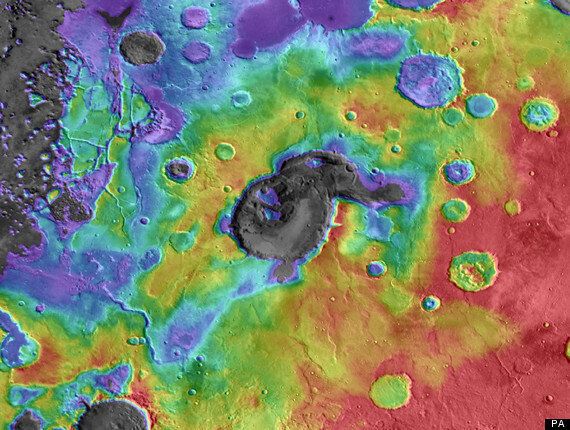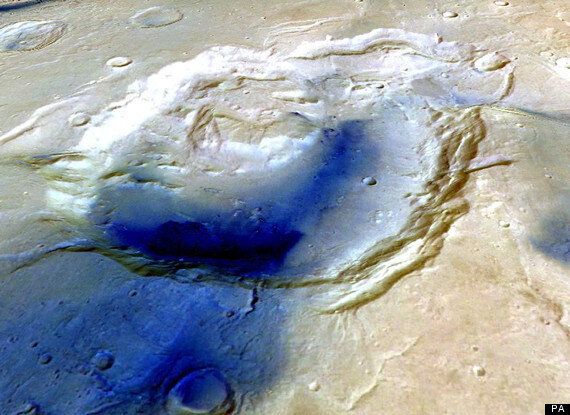Mars wasn't always the dead, dusty world it now appears to be. Its ancient past was far more dramatic, scientists now believe, as the planet was rocked by a series of titanic super-volcanic eruptions.
Crater-like features which could be the footprints of the cataclysmic events have been discovered at several sites in the Martian northern highlands.
Scientists believe they were left behind by massive volcanic explosions that blasted ash and lava out of the planet's surface more than three billion years ago.
Supervolcano eruptions are thousands of times stronger than those of ordinary volcanoes, and powerful enough to alter global climate and cause mass extinctions.

Above: Photo issued by Arizona State University of the colour-coded elevation image of Eden Patera, one of several sites on Mars that may be the footprints of ancient supervolcanoes.
Such eruptions have occurred in Earth's past, and a plugged supervolcano is said to be simmering beneath Yellowstone National Park in the US today.
Rather than producing typical conical mountains of lava and ash, supervolcanoes erupt suddenly in huge explosions.
Because they do not build mountains, evidence of ancient supervolcanoes can be hard to detect. But scientists think they may have formed a series of irregularly shaped craters in an area of Mars known as Arabia Terra.
The ancient, crater-pockmarked region is covered by layers of fine-grained material of unknown origin that could have been left by explosive eruptions.
One of the best examples of what might be a supervolcano remnant is Eden Patera, a depression in the Martian surface 85km wide and 1.8km deep. It is linked to at least three other depressions in what scientists describe as a "caldera complex".
Other supervolcano candidates include the 700 metre-deep Euphrates Patera, and Siloe Patera, a nest of deep craters extending up to 1,750 metres below the surrounding plains.
The volcanoes may have produced powdery deposits identified by Nasa rovers at two landing sites, Meridiani Planum and Gale Crater.

Above: Eden Patera, a potential supervolcano site on Mars, looking toward the east.
Gases released by the eruptions would have altered the Martian climate, according to the scientists writing in the journal Nature.
Lead researcher Dr Joseph Michalski, from the Natural History Museum in London, said: "Discovering supervolcanic structures fundamentally changes how we view ancient volcanism on Mars.
"Many Martian volcanoes are easily recognised from their massive shield-shaped structure, similar to what we see in Hawaii. But these are relatively youthful features on Mars and we have always wondered where the ancient volcanoes are.
"It is possible that the most ancient volcanoes were much more explosive and formed structures similar to what we now see in Arabia Terra."
"It makes sense that supervolcanoes might have been more common on ancient Mars, particularly if the ancient crust was thinner than it is now. This would allow magma to rise to the surface more quickly, before it could release gases within the crust.
"If future work shows that supervolcanoes were present more widely on ancient Mars, it would completely change estimates of how the atmosphere formed from volcanic gases, how sediments formed from volcanic ash and how habitable the surface might have been."